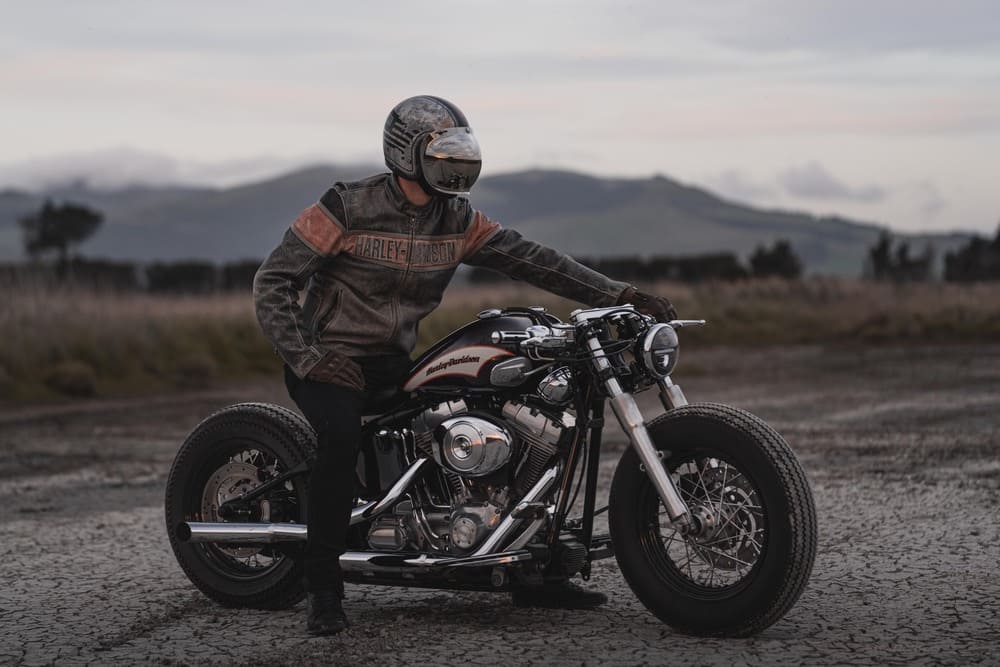
How to Smoothly Stop a Motorcycle the Right Way
For those brand new to the motorcycle game, one of the first challenges that you will encounter is learning to stop smoothly. Sure, motorcycle riding is all about high speeds and good times, but at some point you'll need to come to a stop, preferably without looking like an idiot.
Motorcycles have sequential gear boxes, which makes stopping a little bit more complicated than with a manual transmission car. It takes some practise, and you might be a bit ungraceful on your first few attempts, but smooth braking can be mastered by anyone.
Learning how to properly stop a motorcycle is a crucial skill for any aspiring rider. It not only makes the riding experience a whole lot smoother, but lets you stay in control and keep safe on the road.
How To Stop A Motorcycle: Step-by-Step Guide

To stop a motorcycle correctly, follow this step by step guide:
-
Check your mirrors
This seems obvious, but anyone who has spent some time on a motorcycle will tell you that you're basically invisible to other drivers. You need to know what's going on behind you when planning a stop, because chances are that other drivers will miss you in their field of vision.
-
Roll off the throttle
As you approach a traffic light or anywhere you plan to stop, use your right hand to roll the throttle away from you. This will decrease the power being delivered to the engine and you will immediately feel the bike slowing down.
If there's no traffic around and the lights are far away, you can even complete a stop without applying any brakes whatsoever. Just roll the throttle off and slow down until the light switches green, then pull off in a lower gear.
However, if you need to come to a more sudden or complete stop, we'll run through that process below.
-
Use both the front and rear brakes
Once you've rolled off the throttle, apply both the front brake and rear brake evenly. The clutch lever will still be out at this point because it helps the engine to slow down the motorcycle. Pushing in the clutch without letting the engine slow the motorcycle down means that you will be relying solely on your brakes to stop the bike.
It's important to use both brakes, no matter how many horror stories you've heard of riders eating shit because they grabbed the front brake. Try using just your index and middle finger on the front brake lever so you don't grab too much.
-
Pull in the clutch and downshift
This part can be a bit tricky for new riders. As the motorcycle slows down, the engine's speed or RPM (revolutions per minute) will slow down as well. If you're riding in a higher gear like fourth or fifth, you'll need to apply the clutch then downshift one gear so the bike doesn't jerk or stall.
Sometimes newbie riders immediately grab the clutch and focus on the brakes, which just eliminates all the benefits of engine braking.
-
Match the engine speed and wheel speed with the throttle
The way to avoid the jerk that comes from shifting to a lower gear is to match the engine and wheel speed. It takes some practise, but this process will soon become simple muscle memory.
As you downshift, give a small amount of throttle using just three fingers while applying the clutch. Now slowly release the clutch to engage the drivetrain.
-
Release the clutch to apply engine braking
It takes some practise, but mastering this part will let you make a seamless downshift without the bike jumping ahead because of too much throttle, or jerking to a stop because of too little. Initially, you should release the clutch slowly without needing to match the REVs.
Try to shift gears quickly so the engine speed doesn't drop too much while the clutch is in. This lets the bike slow down quickly and requires less braking force, because of the assistance from the engine.
-
Downshift through the gears until you're nearly stopped
Depending on how fast you were riding and how suddenly you need to stop, you'll need to downshift to a lower gear until the bike is almost at a complete stop.
Many motorcycles have a a tall first gear while the higher gears are clustered together. You may find that your speed initially reduces quite a bit, and then in quick succession downshift through every gear until you're in second.
This sounds like a long process, but it only really takes about a few seconds. Whenever you want to select a lower gear, just downshift, release the clutch and then downshift again.
We don't keep the clutch engaged and downshift three or more gears because it's easy to lose count. If you do this while the bike is still moving fast, it can potentially lock up your rear wheel and cause the motorcycle to skid.
-
Pull in the clutch and move to first gear
Try to be in second gear as you're about to come to a stop. Some bikes might jerk if you downshift into first gear while still moving. As you're about to come to a complete stop, pull the clutch in all the way, downshift to first gear and hold the clutch in.
Ease your grip on the front brake just before the bike stops completely so the front wheel doesn't lose grip and slide forward.
And that's it! You've learned the steps for how to smoothly stop a motorcycle.
Practicing How To Stop a Motorcycle

Once you've got the steps down then it's time to practise what you've learned. Don't overthink it or worry that the process will take away from your overall enjoyment of riding. It's a process we all go through that will eventually become second nature.
So read the steps and re-read them if you've forgotten anything. Practise in a safe area devoid of traffic while you're still getting a handle on things. And remember, don't look down at the controls while practising your stops. They haven't gone anywhere, we promise. Stopping should be completed and practised with your eyes straight ahead.
Protection While Riding
If you're starting off on a bike there's a chance that things won't always go smoothly, or even once you've mastered riding for that matter. That's why amateurs and pros alike protect themselves from head to toe.
Aside from a helmet, you can armour yourself with a good pair of riding pants and a proper motorcycle jacket for some crucial body protection. The best motorcycle gear will be equipped with armour pockets that keep fragile areas like your elbows, knees and hips padded up.
Check out our awesome range of stylish moto wear to see what's on offer in today's market. The right gear has saved many a riders' ass when things go random on the road, like our crash stories will attest to.
FAQs

How do you downshift a motorcycle for beginners?
Braking is one thing, but how do you downshift a motorcycle if you're an absolute beginner? The easiest way to explain it is in steps:
- Roll the throttle closed
- Apply the brakes, keeping them down through the entire downshift process
- Pull in the clutch
- Choose a lower gear with your foot
- Give the throttle a short but measured twist
- Release the clutch lever
- Keep braking until you've reached your desired entry speed
For a more complete rundown of gear shifting, check out the full article linked below.
READ MORE: WHEN TO SHIFT GEARS ON A MOTORCYCLE
How do you downshift a motorcycle smoothly?
How to downshift a motorcycle smoothly is all about timing, preparation and practise. As you anticipate the need to downshift, prepare your bike by easing off the throttle and applying gentle pressure on the brakes.
Next, pull in the clutch lever to disengage power from the engine. Disengaging the clutch plates will allow for smoother gear shifting. As a beginner, just move down one gear at a time. You're not ready for any fancy stuff just yet.
When shifting down, give the throttle a quick and precise twist to slightly increase the engine speed. This matches the engine speed to the lower gear that you're switching into, resulting in a smoother transition. Doing this properly will also extend the life and consistency of your slipper clutch (the thing that allows the clutch to partially slip until the engine speed matches the bike's speed).
Now smoothly release the clutch while simultaneously rolling on the throttle. Once the downshift is complete and the clutch is fully released, adjust the throttle as needed for your desired speed and release the brakes smoothly.
Which foot to put down when stopping a motorcycle?
Which foot to put down when stopping a motorcycle is a common question when starting out. Generally, you should put your left foot down when coming to a stop. We do this because while your left foot supports your weight, your right foot stays on the rear brake pedal, giving you control of the bike and easy access to the rear brake.
Do you hold the clutch while stopping the motorcycle?
Yes, it's recommended that you hold the clutch while stopping a motorcycle. Holding in the clutch while stopping disengages power from the engine, which stops the bike from stalling.
When my bike is standing still, should I select neutral or first gear?
When a bike is standing still, should you select neutral or first gear? Riding schools will differ on this one, but the good news is that you can safely stay in either. It's up to you.
The benefit of staying in first gear with the clutch applied is that you can pull away a lot quicker. This can be useful in stop-start traffic or when the cars behind you are riding up your ass and you want to get clear of the traffic quick smart.
Some people prefer to stay in neutral. It lets you chill out and takes pressure off your wrist from constantly applying the clutch. It also means you won't accidentally lose your grip on the clutch and slip move forward in heavy traffic.
Of course, you can just choose a gear depending on the situation. Stay in first if there's only a few seconds of waiting or put it in neutral if it seems like you're in for a long wait.
Can I stop my motorcycle in second or third gear?
Many new riders ask if you can stop your motorcycle in second or third gear. While it's certainly physically possible, many bikes won't shift down while standing still because power needs to be transmitted from the engine to shift transmission. So play it safe and just shift down to first gear when coming to a stop.
When I downshift on my motorcycle, can I skip gears?
So when you downshift on a motorcycle, can you skip gears? You can downshift as many gears as you want, whether it's just a couple of gears or five. The bike won't stop you, and it can even be done without pulling in the clutch.
However, this is considered a pro move, and since you're reading this article it's safe to assume that you're still getting a handle on things. When pulling this manoeuvre, a rider needs to be certain that the engine and wheel speed matches the appropriate gear, otherwise the bike can jerk and stall.
So until you've got some experience under your belt, downshift gear by gear instead. The more complicated moves will come with time and experience.
Downshifting is a move that's important to master properly. When done incorrectly, it can cause the bike to jerk or completely lock your rear tire in the worst cases.
